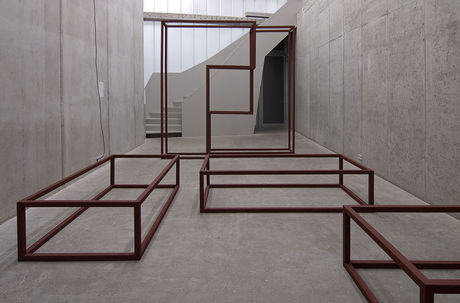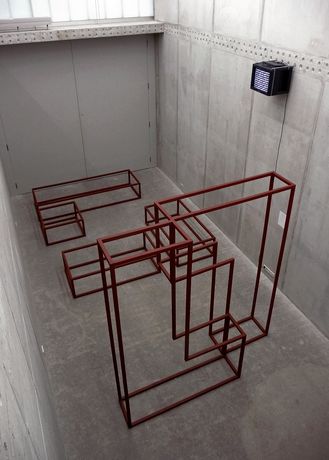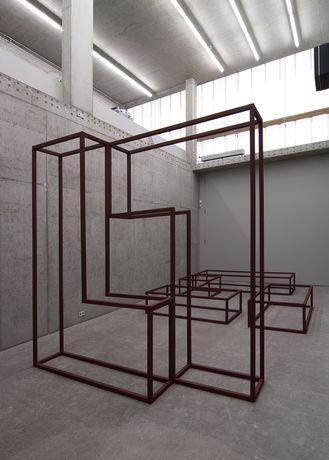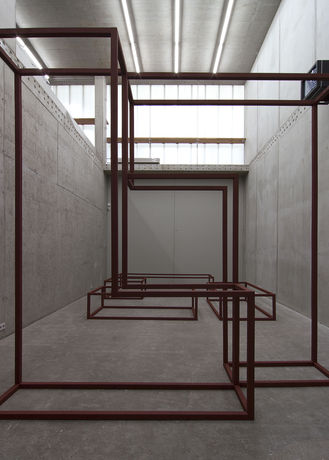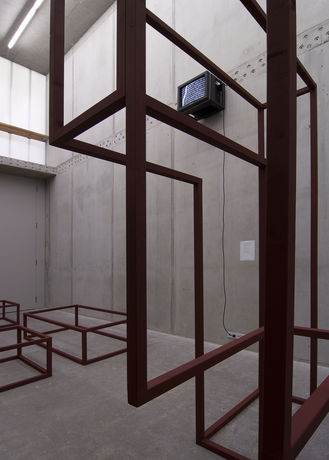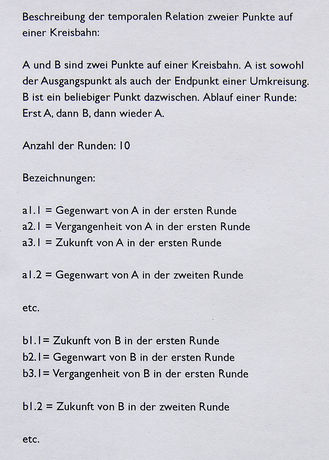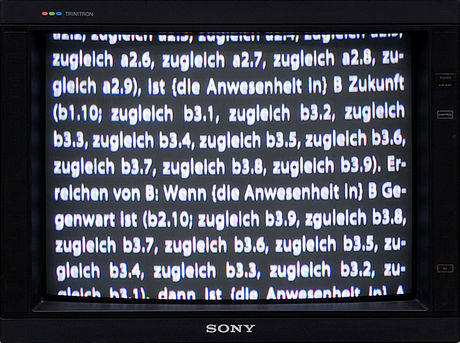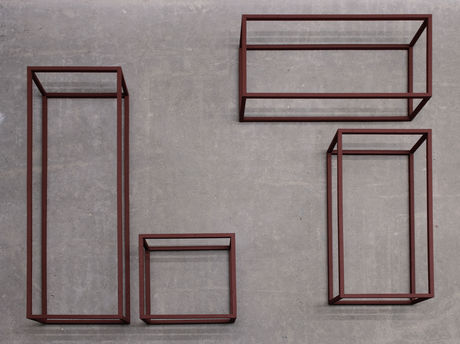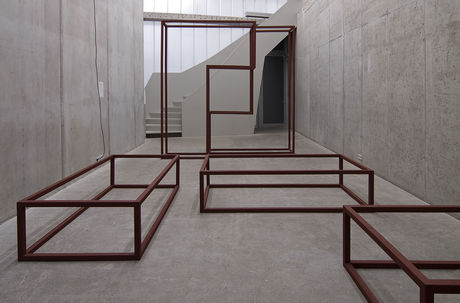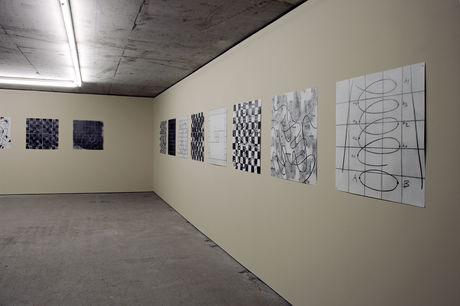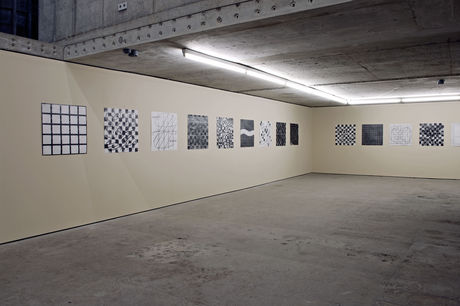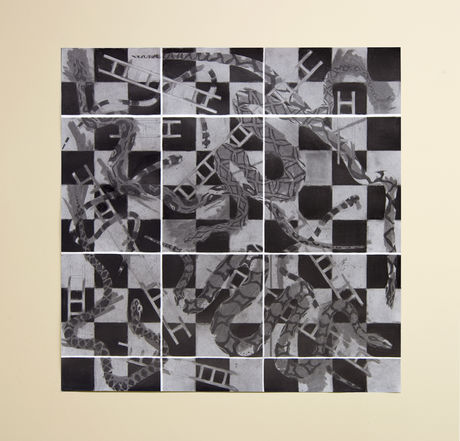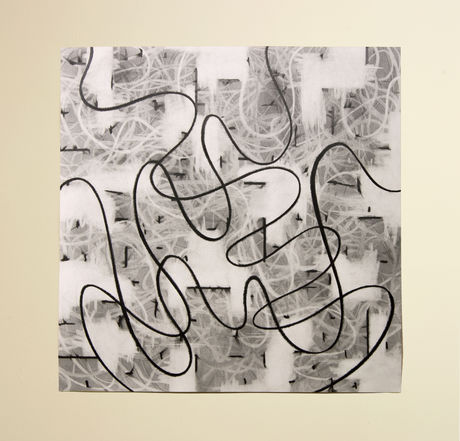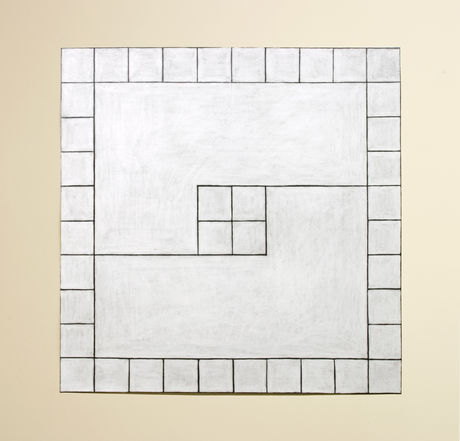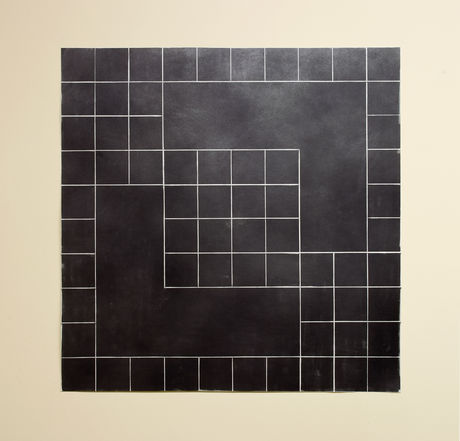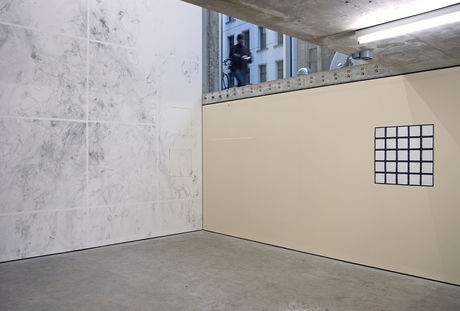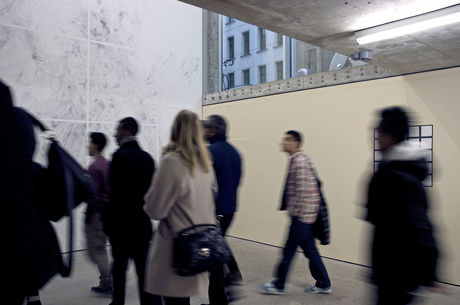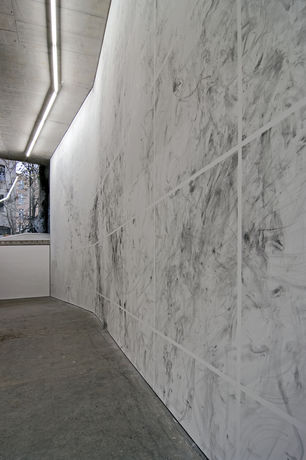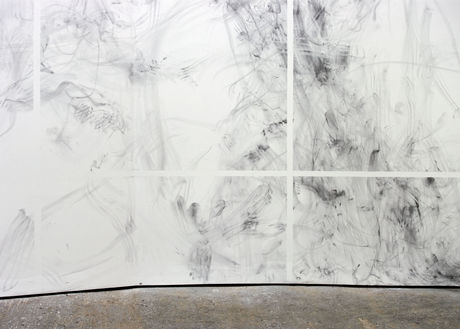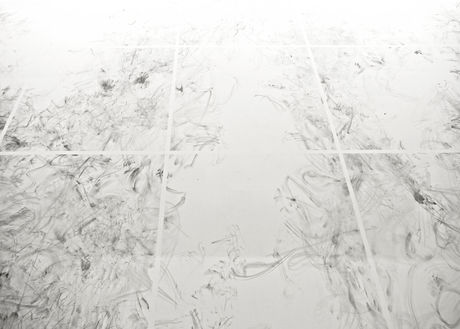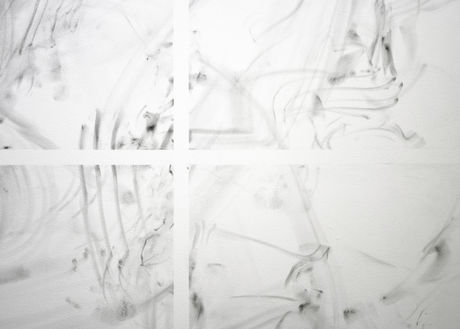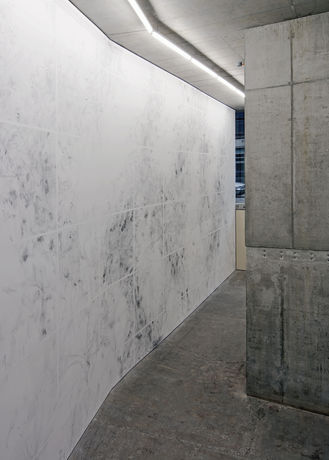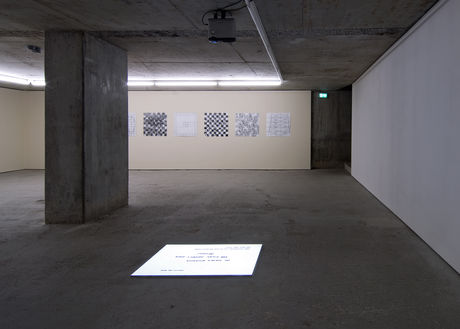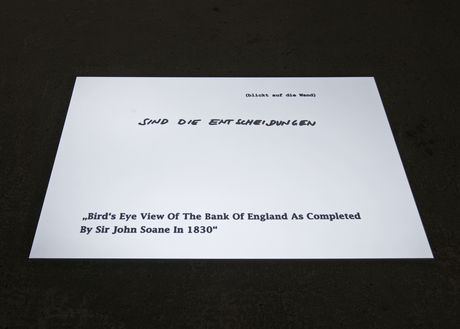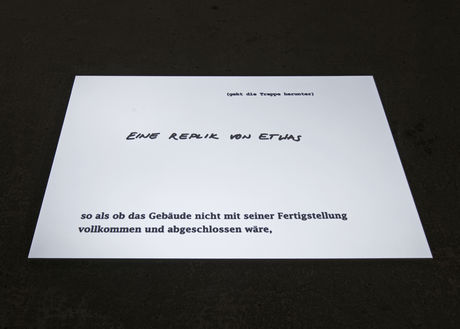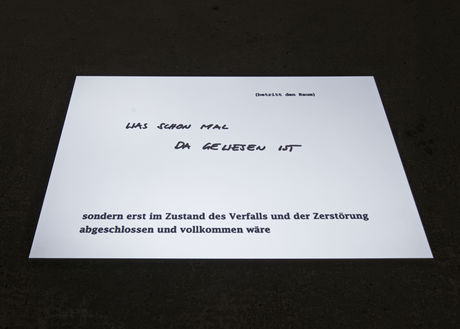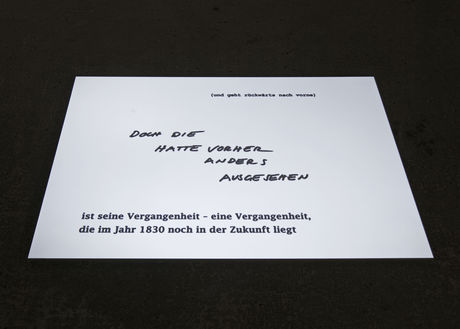Tina Schulz
Nov 5, 2011–Jan 28, 2012
In ancient India, the board-and-dice game “Snakes and Ladders” stood for the power of fate, for strokes of luck and setbacks people can only humbly accept as they come. On their path from the starting square to the finish, players are frequently lifted forward (when they encounter a ladder) or thrown back (when they step on a snake). Strategic skill is of no avail; victory is a matter of pure luck. Tina Schulz adopts formal elements from the board for a seventeen-part series of graphite drawings in which they gradually dissolve. Working with unvarying building blocks—squares and wavy lines—she assembles her decompositions like variations on the theme of captivity in a systemic infinite loop. She takes what lends the game its fate-like structure—the continual return of circular movements through space and time—and applies it to the space of graphical perception, as well as to the overall conception of her first solo exhibition at KOW.
The artist, who was born in 1975, uses the two interlocking L-shaped spaces of the gallery’s architecture to interweave the perception of time, space, and imagery by hewing to a small set of rigorous formal principles, tying it back into itself from exhibit to exhibit. The show opens with a sculptural ensemble that, like a mise en abyme, an image containing a replica of itself, recapitulates the surrounding architecture, rearranging it as a minimalist architectonic body. Next to it, a monitor reflects the movement the visitors to the gallery perform as they walk through the exhibition—from the ground floor down to the basement and back to the ground floor—as a textual animation of a simple logical operation: as the movement From A to B and Back Again to A. As we embark on a tour of the show, our standpoint A is in the present; at the point in time B, however, it will already be behind us—and on the other hand, still before us. If we were to repeat the circular movement From A to B and Back Again to A, moreover, A would already have been both in the past and in the future once before as we reach B a second time, and depart it; etc.
In this manner, Tina Schulz’s exhibition develops moments of (repetitive) temporal synchronicity. It layers past and future, capturing us in spatiotemporal loops of perception, apprehending our sense of time in circular inferences that often elude everyday perception even as they are of systemic relevance to the present. That is illustrated by a picture Tina Schulz outlines in words in another textual animation installed in the basement. In 1830, Joseph Michael Gandy drew a bird’s-eye view of the Bank of England’s new building, which was about to be completed. Yet he showed the construction site of the financial institution’s home as an expanse of rubble. The British national bank’s building site—in ruins? Gandy in fact idealized the rise of the banking house precisely by anticipating its future downfall, casting it in the enveloping sublime light of Romanticism. Only he controls time who already knows how what is emerging passes. And only he who already sees how tomorrow ends can do business with that knowledge today. The picture of the newly constructed bank as a ruin shows past and future hand in hand, elevating the credit institution’s fate above the imponderables of history—an aspiration of (financial) modernism whose presumptuousness we are familiar with.
Tina Schulz integrates the description of Gandy’s picture into her animated film Das Grundgerüst as one of three text loops running in parallel that tie the beholder’s perception of time back to experience in the here and now. She lets the flow of language mirror itself, interweaving it with the reader’s (imaginary) movement through space. Relying on very simple visual means, Schulz’s film as well as her exhibition grasp the performative nature of all cognition as the circular movement of a subject from seeing to interpretation and back to seeing, from action to understanding and back to action. A movement that orients itself in time and space without ever arriving in them altogether: reality is an imagination that incessantly reaches forward and backward within spatiotemporal coordinates. The moment is recollection and projection.
Tina Schulz was born in Munich in 1975. She lives and works in Brussels.
Text and photos: Alexander Koch
The artist, who was born in 1975, uses the two interlocking L-shaped spaces of the gallery’s architecture to interweave the perception of time, space, and imagery by hewing to a small set of rigorous formal principles, tying it back into itself from exhibit to exhibit. The show opens with a sculptural ensemble that, like a mise en abyme, an image containing a replica of itself, recapitulates the surrounding architecture, rearranging it as a minimalist architectonic body. Next to it, a monitor reflects the movement the visitors to the gallery perform as they walk through the exhibition—from the ground floor down to the basement and back to the ground floor—as a textual animation of a simple logical operation: as the movement From A to B and Back Again to A. As we embark on a tour of the show, our standpoint A is in the present; at the point in time B, however, it will already be behind us—and on the other hand, still before us. If we were to repeat the circular movement From A to B and Back Again to A, moreover, A would already have been both in the past and in the future once before as we reach B a second time, and depart it; etc.
In this manner, Tina Schulz’s exhibition develops moments of (repetitive) temporal synchronicity. It layers past and future, capturing us in spatiotemporal loops of perception, apprehending our sense of time in circular inferences that often elude everyday perception even as they are of systemic relevance to the present. That is illustrated by a picture Tina Schulz outlines in words in another textual animation installed in the basement. In 1830, Joseph Michael Gandy drew a bird’s-eye view of the Bank of England’s new building, which was about to be completed. Yet he showed the construction site of the financial institution’s home as an expanse of rubble. The British national bank’s building site—in ruins? Gandy in fact idealized the rise of the banking house precisely by anticipating its future downfall, casting it in the enveloping sublime light of Romanticism. Only he controls time who already knows how what is emerging passes. And only he who already sees how tomorrow ends can do business with that knowledge today. The picture of the newly constructed bank as a ruin shows past and future hand in hand, elevating the credit institution’s fate above the imponderables of history—an aspiration of (financial) modernism whose presumptuousness we are familiar with.
Tina Schulz integrates the description of Gandy’s picture into her animated film Das Grundgerüst as one of three text loops running in parallel that tie the beholder’s perception of time back to experience in the here and now. She lets the flow of language mirror itself, interweaving it with the reader’s (imaginary) movement through space. Relying on very simple visual means, Schulz’s film as well as her exhibition grasp the performative nature of all cognition as the circular movement of a subject from seeing to interpretation and back to seeing, from action to understanding and back to action. A movement that orients itself in time and space without ever arriving in them altogether: reality is an imagination that incessantly reaches forward and backward within spatiotemporal coordinates. The moment is recollection and projection.
Tina Schulz was born in Munich in 1975. She lives and works in Brussels.
Text and photos: Alexander Koch
